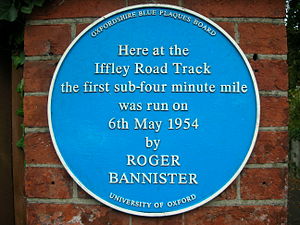
On that fateful day in 1954, there were just 1,000 people in attendance at the University of Oxford running track. At the time, Bannister was a 25 year-old medical student. Today, he is Sir Roger Bannister, neurosurgeon.
The physical barrier that was broken that day was significant. People wondered if the 4 minute barrier would ever be broken. Was it possible physically? When he crossed the finish line with a time of 3 minutes, 59.4 seconds, not only did he break through a perceived physical barrier, but he broke through a tremendous psychological barrier as well.
One man, four minutes, and suddenly there were new perceptions on the limits of human performance.
Within 46 days of the record being broken, it was broken again by John Landy. Bannister and Landy raced later in the year in the "Mile of the Century" at Vancouver – and became the first time two men in one race to break four minutes (Bannister won in 3:58.8 to Landy's 3:59.6). By the end of 1957, 16 runners had logged sub-4-minute miles. Barrier? What barrier?
All it took was pushing the envelope of our thinking, much like Yeager did in 1947. At that time, the prevailing thought was that if you broke the speed of sound, you wouldn’t live to tell the tale. We all know that Yeager proved that wrong, thus providing a departure point for the space program. Just watch Yeager strap himself into “Glamorous Glennis” (the Bell X-1) in the movie “The Right Stuff” (or read Yeager’s autobiography, simply entitled " Yeager: An Autobiography"" ). It is intriguing to gain insight into the mind and thinking of someone pushing the limits of thought – perhaps without even realizing it at the time. Epic stuff, indeed.
Bannister shattered a barrier much like Yeager did. Bannister recounted his story in “The Four-Minute Mile". In this, he described his training program, and the lead-up to the event itself. Again, it is intriguing to explore the thinking and perceptions involved in what was to become an epic human performance in the history of track and field.
You can debate whether or not a four minute mile (or running 15 mph) is the equivalent of strapping your backside to an aircraft travelling at the speed of sound (768 mph). But both involved a significant change in perceptions and beliefs relative to the established norms of the era. Both involved having the guts to lose sight of the shore to go someplace that they really didn’t know existed or not. Both involved pushing the envelope – of our thinking.
What barriers are limiting you today? And what can you do to break them down?
Photo credits: Wikipedia

 "Running Injuries: Etiology And Recovery- Based Treatment" (co-author Bridget Clark, PT) appears in the third edition and fourth editions of "Clinical Orthopaedic Rehabilitation: A Team Approach" by Charles Giangarra, MD and Robert C. Manske, PT.
"Running Injuries: Etiology And Recovery- Based Treatment" (co-author Bridget Clark, PT) appears in the third edition and fourth editions of "Clinical Orthopaedic Rehabilitation: A Team Approach" by Charles Giangarra, MD and Robert C. Manske, PT.
 Allan Besselink, PT, DPT, Ph.D., Dip.MDT has a unique voice in the world of sports, education, and health care. Read more about Allan here.
Allan Besselink, PT, DPT, Ph.D., Dip.MDT has a unique voice in the world of sports, education, and health care. Read more about Allan here.
 Top 5 finalist in three categories: "Best Overall Blog", "Best PT Blog" and "Best Advocacy Blog".
Top 5 finalist in three categories: "Best Overall Blog", "Best PT Blog" and "Best Advocacy Blog".